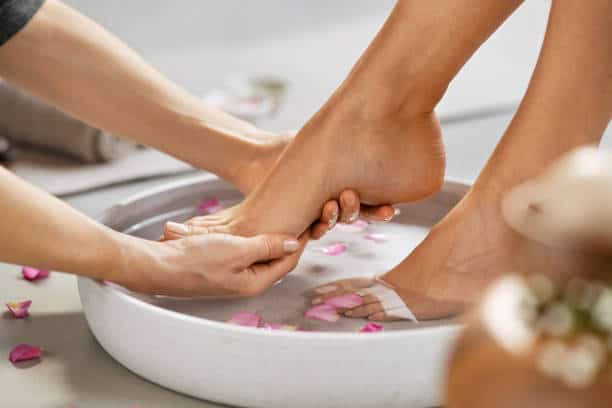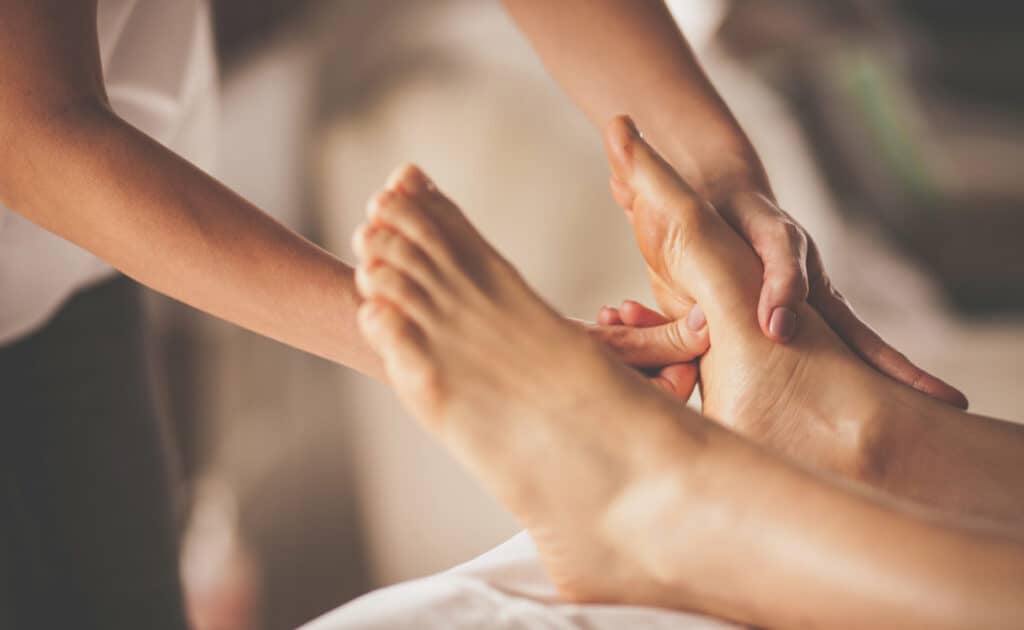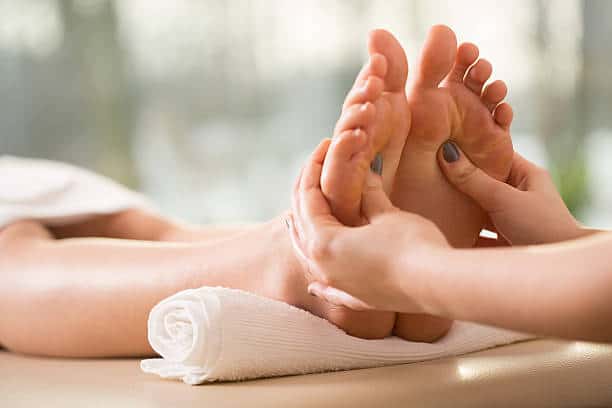Many expecting mothers have heard the rumor that pedicures can potentially induce labor. But is there any truth to these claims?
For those nearing the end of their pregnancy journey, exploring various methods to induce labor naturally may seem both enticing and confusing. This article discusses the relationship between pedicures and labor induction, and whether or not it holds any weight.
Pedicures are common cosmetic treatments primarily focused on the care and appearance of the feet and toenails. During pregnancy, receiving a pedicure can provide a much-needed relaxing experience for those who are dealing with swollen and aching feet.
While some claim that specific foot massages or reflexology during pedicures could, in theory, encourage labor, such beliefs often stem from anecdotal evidence rather than scientific research.
Key Takeaways
- Pedicures are a popular topic for claims of labor induction
- The idea may originate from reflexology and foot massage techniques
- There is currently no concrete scientific evidence supporting these claims
What Does a Pedicure Involve

A pedicure is a cosmetic treatment for the feet and toenails, typically performed at a salon by a professional pedicurist or manicurist. The process begins with soaking the feet in warm water to soften the skin and nails, allowing for a more comfortable and efficient treatment.
Pedicures can help maintain overall foot health, enhance the appearance of the feet, and provide relaxation for the client.
Once the feet have been soaked, the pedicurist uses various tools such as clippers, nail files, and cuticle pushers to carefully trim, shape, and clean the toenails. Attention is also given to the cuticles, which are often pushed back to promote healthier nail growth and prevent ingrown nails.
The next step in a pedicure involves the removal of dead skin and calluses from the feet. This can be done using a foot file, pumice stone, or a specialized callus remover. By eliminating rough patches and dead skin, the feet are left feeling soft, smooth, and revitalized.
Following the exfoliation process, a moisturizing lotion or cream is massaged into the feet to hydrate the skin and provide a soothing sensation. This step not only helps to lock in moisture and improve the overall texture of the skin but also allows the client to enjoy a relaxing foot massage.
Once the feet are prepped and pampered, the pedicurist moves on to the application of polish. To begin, a base coat is applied to provide a smooth surface and help the polish adhere to the nail.
Then, the client’s choice of colored polish is carefully applied, typically in two coats for optimal coverage, followed by a glossy topcoat to seal and protect the nail from chips and wear.
Overall, a pedicure involves a series of meticulous steps and techniques, executed by a skilled pedicurist or manicurist using a variety of salon tools and products. The service aims to not only improve the appearance of the toenails but also promote overall foot health, comfort, and relaxation.
Pedicures and Pregnancy
Pregnant women often look for ways to relax and practice self-care during their pregnancy. One popular method is getting a pedicure, providing some pampering and relief to their often swollen and tired feet.
However, some may wonder if a pedicure can induce labor, especially in the later stages of pregnancy.
In the first trimester, pregnant women are generally encouraged to practice relaxation techniques and enjoy self-care activities like pedicures. Due to the low risk of complications and the numerous benefits they provide, such as stress relief, pedicures are a safe choice for pregnant women during this stage.
As the pregnancy progresses to the third trimester, some might be concerned about potential triggers for labor. There are discussions suggesting that a pedicure could induce labor due to the pressure points in the feet that can stimulate contractions.
However, current evidence shows that these points would need to be specifically targeted and applied with significant force, something that is unlikely to occur during a regular pedicure.
In general, pregnant women can still enjoy a pedicure in the third trimester, as long as they inform their pedicurist about their pregnancy and avoid any deep massage or excessive stimulation of pressure points on the feet.
It is essential to be mindful of salon cleanliness and hygiene practices, as pregnant women are more susceptible to infections.
So, while the idea of a pedicure inducing labor is not backed by strong evidence, it is always recommended to consult your healthcare provider before engaging in any self-care activities during pregnancy.
In the end, having a pedicure during pregnancy can be a lovely way to relax, unwind, and give your feet a well-deserved break, as long as it is done safely and with the approval of your healthcare professional.
Foot Massage and Labour Induction

Foot massage, specifically targeting pressure points and using techniques such as reflexology and acupressure, has long been associated with inducing labor in pregnant women.
The ancient healing practice of reflexology aims to restore the body’s balance by applying pressure to specific points on the feet, which correspond to different organs and systems. Acupressure, on the other hand, releases the body’s energy flow by stimulating various meridians.
There are certain pressure points on the feet that, when stimulated, are believed to help induce labor. For instance, the inside of the ankle near the Achilles tendon, and the area between the big toe and second toe are just a few examples.
Applying gentle pressure to these points may trigger the release of oxytocin, a hormone that causes uterine contractions and helps initiate labor.
The idea of using foot massage to induce labor stems from the belief that massaging these pressure points can help stimulate energy fields within the body and enhance overall circulation. Improved circulation, in turn, can aid the process of natural labor induction.
However, it is important to approach the concept of using foot massage for labor induction with caution. While some anecdotal reports support the effectiveness of this method, there is limited scientific evidence to back up such claims.
Moreover, attempting to induce labor without the guidance of a healthcare professional can lead to unnecessary complications and risks for both mother and baby.
In conclusion, foot massage and the use of pressure points can provide relief and relaxation during pregnancy, but its effectiveness in inducing labor is not well-established. Expecting mothers should consult with their healthcare provider before attempting any labor-inducing techniques, including foot massage.
Risks Involved with Pedicures during Pregnancy
Pregnancy is a time when extra care should be taken to ensure the health and well-being of both the mother and the baby. While pedicures may provide relaxation and comfort, there are several risks involved with getting a pedicure during pregnancy.
Infections: One of the primary concerns while getting a pedicure during pregnancy is the risk of infections. Unclean tools, such as nail clippers, and unsanitary environments might expose the mother to harmful bacteria or viruses.
It is essential to choose a salon that has high health inspection scores and maintains proper hygiene practices to minimize this risk.
Broken skin: During a pedicure, there is a possibility of broken skin, especially if callus removal is involved. This could provide an entry point for infections that might pose a risk to the pregnant woman’s health. It is crucial to communicate with the pedicurist to ensure they handle sensitive areas gently, avoiding any cuts or abrasions.
Fungus: The warm, moist environment of pedicure tubs can be a breeding ground for fungus. Contracting a fungal infection during pregnancy could lead to discomfort and complications. Pregnant women should choose salons that properly disinfect their tubs and use disposable liners.
Dehydration and hyperthermia: Many salons offer hot water soaks during a pedicure, which can lead to an increase in body temperature.
Pregnant women should avoid soaking their feet in hot water for an extended period, as excessive heat could cause dehydration and hyperthermia, potentially harming the developing fetus. Mothers-to-be should opt for warm water instead, and limit the soak time.
In conclusion, expectant mothers should be cautious and mindful of these risks while considering a pedicure during pregnancy. Opting for salons that adhere to strict hygiene standards, avoiding hot water soaks, and being gentle with foot care can help reduce these risks and ensure a safer experience.
Precautions while Having Pedicure

Pregnancy often brings a variety of physical changes and discomforts. As a result, many expecting mothers look to self-care such as pedicures to provide some relaxation.
However, one should take several precautions while having a pedicure, especially during the later stages of pregnancy.
Firstly, always opt for a safe and well-established salon. Make sure the salon follows proper sanitization methods and has undergone a recent health inspection.
Cleanliness is essential to avoid infections that could potentially harm the expecting mother or the baby.
Secondly, be mindful of the products used during the pedicure. While most ingredients found in polishes and lotions are considered safe, there might be some chemicals that could pose risks, particularly fumes emitted from specific products.
Look for non-toxic or pregnancy-safe alternatives, and if you’re unsure about a product, consult with your healthcare provider beforehand.
Additionally, it is crucial to ensure proper ventilation in the salon. Inhaling fumes from chemicals used in pedicures can cause headaches, nausea, and dizziness. Make sure the salon space is well-ventilated, and avoid peak hours when it may be crowded or poorly ventilated.
Lastly, communication with the pedicurist is essential. Inform them that you are pregnant and request necessary adjustments. For instance, ask them to avoid applying strong pressure around the ankle and Achilles tendon, as these points are believed to be linked to the uterus and can potentially induce labor.
By taking these precautions, you can minimize the risks and enjoy a relaxing pedicure during pregnancy.
Scientific View on Pedicures and Labour Induction
There is currently no scientific evidence that directly links pedicures to inducing labor in mothers. Some people believe that massaging certain pressure points in the feet can lead to labor induction, but this notion lacks consistent evidence to support it.
During pregnancy, the uterus is responsible for contracting and expanding, playing a crucial role in the birthing process. The involvement of other organs and various factors also contributes to the onset of labor.
Scientifically, the start of labor is triggered by a complex interaction of hormones, including the release of oxytocin, which initiates and regulates contractions.
While it is true that certain pressure points in the body can stimulate the release of oxytocin, it is unclear whether foot massages, such as the ones performed during pedicures, have a direct impact on inducing labor.
Pressure points are present on various parts of the body, including the hands, which have also been used in the practice of acupressure and reflexology. However, due to the lack of rigorous scientific research, these findings are not conclusive.
Additionally, each woman’s body responds differently to various stimuli, making it impossible to predict the exact impact of a pedicure on an expecting mother.
While some women have reported experiencing contractions after a foot massage or pedicure, they remain anecdotal, and coincidental occurrences may have contributed to the timing of labor.
In summary, although pedicures can promote relaxation and alleviate discomfort in the feet of pregnant women, they are not scientifically proven to induce labor. It is essential to consult with a healthcare professional on safe and effective ways to facilitate the birthing process.
Anecdotal Claims and Pedicures
Anecdotal evidence suggests that some individuals believe pedicures can induce labor. Often, these claims are based on personal experiences wherein a woman goes into labor shortly after receiving a pedicure.
However, it’s important to approach these anecdotes with a neutral and clear understanding, as there is no scientific evidence to support these claims.
Swollen feet are a common issue during pregnancy, and many women seek relief through pedicures. The benefits of a pedicure are not limited to aesthetic improvements, as they can also alleviate pressure and swelling in the feet.
The hot water used during the process may provide additional comfort and relaxation for the expecting mother.
The steps involved in a pedicure typically include soaking the feet in warm water, followed by exfoliation, massage, and nail care. Some individuals attribute labor induction to specific aspects of the pedicure, such as the foot massage or the pressure points targeted during the process.
However, it is essential to emphasize that there is no concrete scientific evidence supporting these claims.
In conclusion, while anecdotal claims suggest that pedicures might induce labor, there is no scientific basis for this belief.
Nevertheless, pedicures provide comfort and relaxation for pregnant women experiencing swollen feet and should be regarded as a safe and enjoyable form of self-care during pregnancy.
Pedicure Alternatives for Inducing Labor
Prenatal massage is a popular alternative for inducing labor. This specialized massage technique focuses on relaxation and the specific needs of pregnant women.
By targeting specific pressure points and using certain massage strokes, prenatal massage may help to stimulate the body’s natural labor-inducing processes. However, it is crucial to consult with a certified prenatal massage therapist before attempting any massage techniques.
Another natural method for inducing labor is engaging in sexual activity. It is believed that sex, specifically orgasm, can cause uterine contractions and help to kick-start labor.
In addition to this, the hormones released during intimacy can also promote relaxation and reduce stress, which can be helpful for expectant mothers. As with any method, it is important to consult with a doctor before trying to induce labor using sex.
Foot massages, while different from a pedicure, can also provide relief for pregnant women and could potentially induce labor. Massaging specific areas of the foot is reported to help stimulate labor, although there is no scientific evidence to back this claim.
Nonetheless, a foot massage may offer relaxation and contribute to reducing the stress experienced during the final stages of pregnancy.
Making sure to discuss any beauty treatment options with a healthcare professional is essential before attempting to induce labor. Although various natural and non-invasive methods may be helpful, these alternatives should be considered in consultation with a doctor.
In summary, prenatal massage, sex, and foot massages are potential alternatives to pedicures for inducing labor. Remember to approach these methods with caution and always consult a medical professional before trying any labor-inducing practices.
Related post: Midwives Brew Success at 37 Weeks
Frequently Asked Questions
How can a foot massage lead to labor?
A foot massage, specifically targeting certain pressure points, can potentially stimulate the release of oxytocin, a hormone responsible for uterine contractions. This may lead to labor, especially if the expectant mother is near her due date.
However, research on this topic is limited, so the effectiveness of foot massages to induce labor is not yet established.
There are several pressure points believed to be related to inducing labor. Some of the most commonly mentioned include the Spleen 6 (located on the inner ankle), the Large Intestine 4 (located on the hand, between the thumb and index finger), and the Bladder 60 (located on the back of the ankle).
However, it is important to note that evidence regarding the effectiveness of using these pressure points to induce labor is limited.
Is it safe to receive a pedicure near the end of pregnancy?
It is generally safe to receive a pedicure during pregnancy, as long as proper hygiene practices are followed and the salon is clean. However, it is important for pregnant women to inform the technician about their pregnancy, as certain massage techniques or pressure points may not be recommended.
As always, it is best to consult a healthcare provider before receiving any treatment during pregnancy.
Can reflexology help start labor?
Reflexology is a complementary therapy that involves applying pressure to specific points on the feet, hands, and ears. Some believe that these points correspond to organs and systems within the body, including the reproductive system.
While certain reflexology points are believed to help with inducing labor, limited scientific research supports this claim. Pregnant women should consult their healthcare provider before trying reflexology or any other alternative therapy for inducing labor.
What are natural ways to induce labor?
Several natural methods are believed to help induce labor, such as:
Walking or physical activity
Sexual intercourse
Nipple stimulation
Warm baths
Consuming spicy foods or certain herbs
However, the effectiveness of these methods varies, and medical professionals should be consulted before attempting any natural labor induction activities.
Do certain foods, like pineapple, help in inducing labor?
There are claims that consuming particular foods, like pineapple, can help induce labor. Pineapple contains an enzyme called bromelain, which is believed to help soften the cervix.
However, there is limited scientific evidence to support this claim, and more research is needed to confirm the effectiveness and safety of this method.

Iesha is a loving mother of 2 beautiful children. She’s an active parent who enjoys indoor and outdoor adventures with her family. Her mission is to share practical and realistic parenting advice to help the parenting community becoming stronger.
